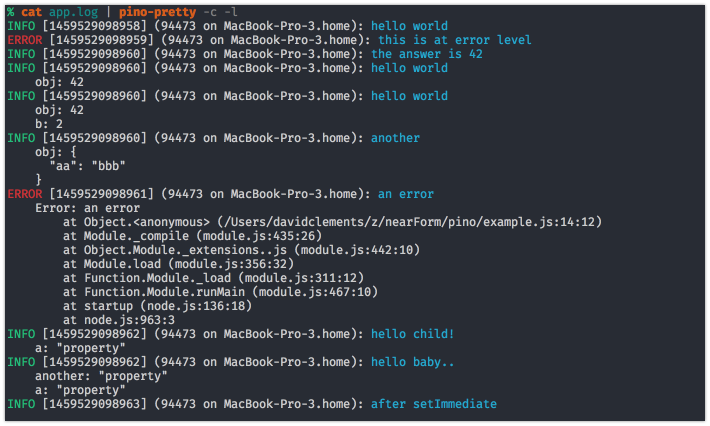Very low overhead Node.js logger.
- Benchmarks ⇗
- API ⇗
- Browser API ⇗
- Redaction ⇗
- Child Loggers ⇗
- Transports ⇗
- Web Frameworks ⇗
- Pretty Printing ⇗
- Asynchronous Logging ⇗
- Ecosystem ⇗
- Legacy
- Help ⇗
- Long Term Support Policy ⇗
$ npm install pino
If you would like to install pino v6, refer to https://github.com/pinojs/pino/tree/v6.x.
const logger = require('pino')()
logger.info('hello world')
const child = logger.child({ a: 'property' })
child.info('hello child!')This produces:
{"level":30,"time":1531171074631,"msg":"hello world","pid":657,"hostname":"Davids-MBP-3.fritz.box"}
{"level":30,"time":1531171082399,"msg":"hello child!","pid":657,"hostname":"Davids-MBP-3.fritz.box","a":"property"}
For using Pino with a web framework see:
- Pino with Fastify
- Pino with Express
- Pino with Hapi
- Pino with Restify
- Pino with Koa
- Pino with Node core
http - Pino with Nest
The pino-pretty module can be used to
format logs during development:
Due to Node's single-threaded event-loop, it's highly recommended that sending, alert triggering, reformatting and all forms of log processing be conducted in a separate process or thread.
In Pino terminology we call all log processors "transports", and recommend that the
transports be run in a worker thread using our pino.transport API.
For more details see our Transports⇗ document.
Using minimum resources for logging is very important. Log messages tend to get added over time and this can lead to a throttling effect on applications – such as reduced requests per second.
In many cases, Pino is over 5x faster than alternatives.
See the Benchmarks document for comparisons.
https://github.com/pinojs
https://www.npmjs.com/~matteo.collina
https://twitter.com/matteocollina
https://github.com/davidmarkclements
https://www.npmjs.com/~davidmarkclements
https://twitter.com/davidmarkclem
https://github.com/jsumners
https://www.npmjs.com/~jsumners
https://twitter.com/jsumners79
https://github.com/watson
Pino is an OPEN Open Source Project. This means that:
Individuals making significant and valuable contributions are given commit-access to the project to contribute as they see fit. This project is more like an open wiki than a standard guarded open source project.
See the CONTRIBUTING.md file for more details.
This project was kindly sponsored by nearForm.
Logo and identity designed by Cosmic Fox Design: https://www.behance.net/cosmicfox.
Licensed under MIT.

